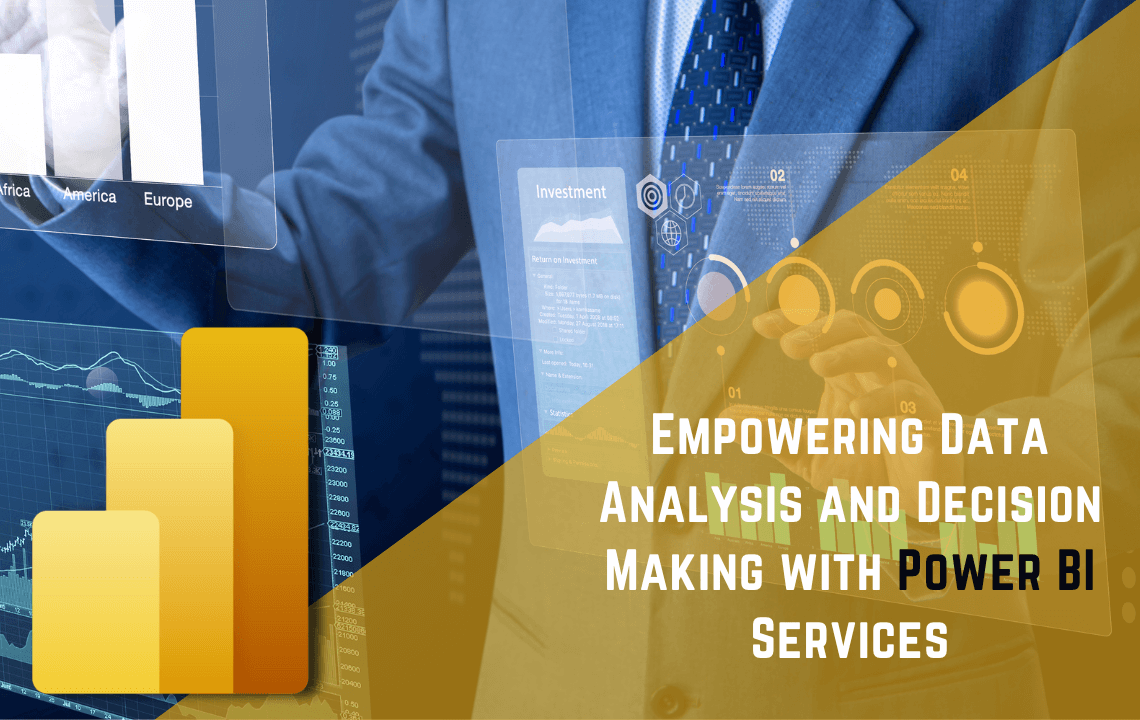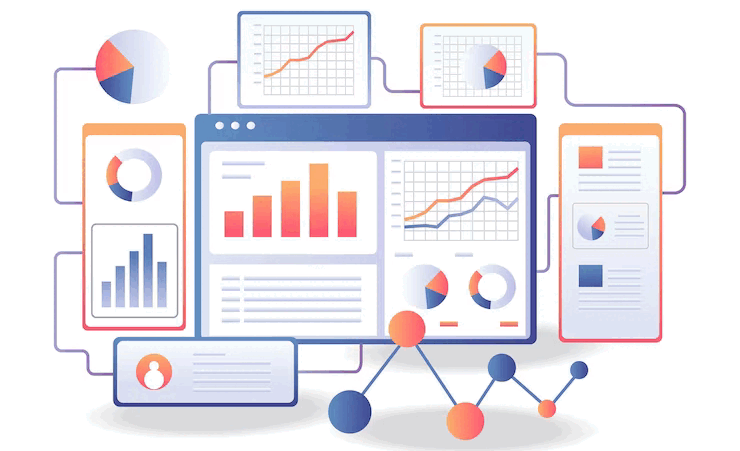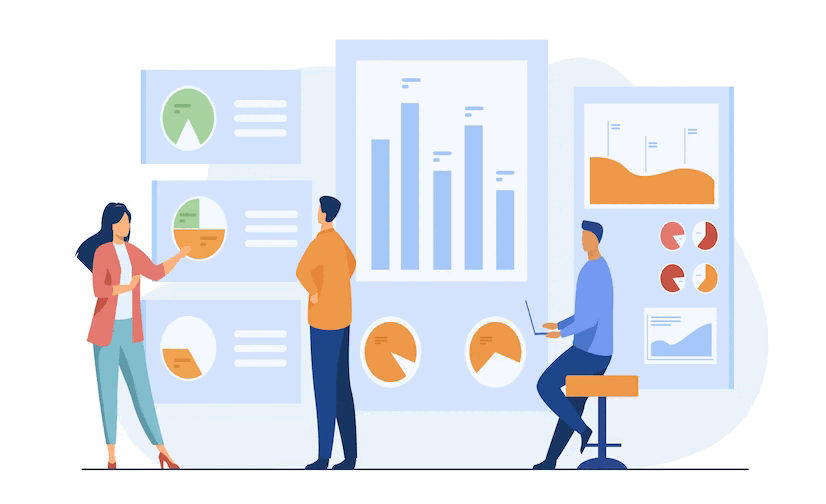Empowering Data Analysis and Decision Making with Power BI Services
- 1 Empowering Data Analysis and Decision Making
- 1.1 Power BI Services
- 1.2 Sharing and Collaboration
- 1.3 Data Connectivity
- 1.4 Data Preparation and Transformation
- 1.5 Data Modeling and Visualization
- 2 Benefits of Power BI
- 2.1 Enhanced Data Analysis
- 2.2 Real-time Data Monitoring
- 2.3 Mobile Access and Cross-Platform Compatibility
- 2.4 Data Collaboration and Insights Sharing
- 2.5 Scalability and Integration
- 2.6 No Specialized Technical Assistance Needed
- 3 What is PowerBI, and why is it used?
- 4 Wrapping Up
In today’s data-driven world, organizations are constantly challenged to make sense of vast information and extract valuable insights.
Power BI, a business analytics service developed by Microsoft, has emerged as a powerful tool that enables businesses to visualize and analyze data to drive informed decision-making.
As a Microsoft Power Platform company in Germany, we are thrilled to bring you this blog post, exploring the incredible potential of Power BI services for data analysis and decision-making. Microsoft has established itself as a leader in the technology industry, and its Power Platform offerings have revolutionized how businesses operate and thrive.
Empowering Data Analysis and Decision Making
Power BI Services
The Power BI Service is a cloud-based platform designed for business analytics and data visualization. It empowers individuals to analyze and visualize data swiftly with enhanced efficiency and comprehension. By providing access to a diverse array of data sources, it facilitates seamless connections for users. Through intuitive dashboards, interactive reports, and captivating visual representations, the Power BI Service breathes life into data, enabling users to gain valuable insights.
Power BI offers a comprehensive service suite covering the entire data analysis lifecycle. These services include:
Sharing and Collaboration
Power BI offers a range of options for sharing and collaborating on reports and dashboards. Users can publish their visualizations to the Power BI service, making them accessible to others within or outside their organization. Power BI Dashboards also provide robust security and access controls, ensuring that sensitive data remains protected.
Data Connectivity
Power BI lets users connect to various data sources, such as databases, cloud services, spreadsheets, and even on-premises systems. It provides seamless integration with popular platforms like Microsoft Excel, Azure, SQL Server, SharePoint, and many others, enabling easy access to data from diverse sources.
Data Preparation and Transformation
The Power Query Editor within Power BI enables users to cleanse, transform, and shape data to meet their specific analysis requirements. It offers an intuitive interface to perform data cleansing tasks, handle missing values, combine data from different sources, and create calculated columns or measures. These capabilities streamline the data preparation process, saving valuable time and effort.
Data Modeling and Visualization
Power BI’s core strength lies in its ability to create compelling visualizations that make data more accessible and meaningful. The Power BI Desktop application allows users to build interactive dashboards, reports, and charts using a drag-and-drop interface. It offers a rich collection of pre-built visuals and customization options to present data most effectively.
This blog explores Power BI services and its numerous benefits to organizations.
Benefits of Power BI
Implementing Power BI within an organization can yield numerous benefits, including:
Enhanced Data Analysis
Power BI empowers users to perform in-depth data analysis by providing a user-friendly interface and vast analytical capabilities. The ability to create interactive visuals, drill down into details, and apply filters and slicers enables users to uncover hidden patterns, trends, and insights. This, in turn, supports data-driven decision-making at all levels of the organization.
Real-time Data Monitoring
Power BI supports real-time data streaming, allowing organizations to monitor key metrics and business performance. By connecting to live data sources or leveraging APIs, Power BI enables the creation of dynamic dashboards that update automatically. Real-time monitoring facilitates timely responses to critical events, allowing organizations to make proactive decisions.
Mobile Access and Cross-Platform Compatibility
Power BI provides native apps for various platforms, including Windows, iOS, and Android. This cross-platform compatibility allows users to access reports and dashboards on the go, enabling timely insights and decision-making regardless of location. The responsive design of Power BI visuals ensures a seamless experience across different devices and screen sizes.
Data Collaboration and Insights Sharing
With Power BI, organizations can foster a culture of data-driven decision-making by encouraging collaboration and sharing of insights. The ability to share reports and dashboards with stakeholders internally and externally promotes transparency and alignment. Power BI’s collaboration features, such as commenting, annotation, and sharing through email or direct links, facilitate meaningful discussions around data.
Scalability and Integration
Power BI seamlessly integrates with other Microsoft products and services, such as Azure, Office 365, and Dynamics 365. This integration allows organizations to leverage their existing technology investments and provides a scalable data analysis and reporting ecosystem. Power BI’s cloud-based architecture ensures scalability, allowing organizations to handle large datasets and accommodate growing analytical needs.
No Specialized Technical Assistance Needed
Power BI enables agile exploration and analysis effortlessly, eliminating specialized technical support requirements. It boasts a robust natural language interface and intuitive graphical designer tools to facilitate a seamless user experience.
What is PowerBI, and why is it used?
Wrapping Up
Power BI has revolutionized how organizations analyze and visualize data, enabling them to unlock valuable insights and make informed decisions.
Its comprehensive suite of services, including data connectivity, preparation, modeling, and visualization, coupled with numerous benefits such as enhanced data analysis, real-time monitoring, mobile access, collaboration, and scalability, make it a powerful tool for businesses of all sizes.
By harnessing the capabilities of Power BI, organizations can navigate the complex data landscape, gain a competitive edge, and drive success in today’s data-centric world.
Happy Reading!!



















